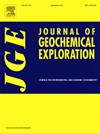环境条件下锑的厌氧氧化:pH值、土壤吸附和微生物群落的复杂作用
IF 3.3
2区 地球科学
Q1 GEOCHEMISTRY & GEOPHYSICS
引用次数: 0
摘要
Sb(III)氧化为Sb(V)降低了Sb的毒性,在厌氧条件下,硝酸盐作为电子受体与Sb(III)氧化耦合。然而,锑在环境条件下的厌氧氧化行为尚未得到很好的阐明。研究了Sb(III)在土壤和无土微生物中的厌氧氧化,并跟踪了不同pH值下Sb(III)和Sb(V)的土壤吸附、微生物吸附和细胞内积累情况。在土壤微观环境中,Sb(III)和Sb(V)的吸附率分别高达96.5%和19.4%,酸性条件有利于Sb(V)的吸附。在无土环境中,微生物对Sb的影响也与ph值有关。碱性条件下Sb(III)吸附在细胞表面的量大于Sb(V),中性条件下Sb(III)和Sb(V)的胞内积累量最大。土壤的存在显著改变了微生物群落的组成,丰富了厌氧sb氧化类群,包括芽孢杆菌和Ensifer,并有可能提高微生物的整体代谢活性。这些结果表明Sb在环境条件下的厌氧氧化是一个复杂的过程,涉及许多非生物和生物因素。土壤吸附是导致捕获弱硝酸盐依赖性Sb氧化的主要干扰因素。在这项研究中,研究了土壤pH值和微生物对锑存在模式和潜在运输行为的影响,为锑污染土壤的修复提供了重要的见解,特别是在厌氧环境中。本文章由计算机程序翻译,如有差异,请以英文原文为准。

Anaerobic oxidation of antimony under ambient conditions: Complex roles of pH value, soil adsorption and microbial community
The oxidation of Sb(III) to Sb(V) reduces the toxicity of Sb, and nitrate acts as an electron acceptor coupled with Sb(III) oxidation under anaerobic conditions. However, the behavior of antimony anaerobic oxidation under ambient conditions has not been well elucidated. This work investigated the anaerobic oxidation of Sb(III) in soil and soilless microcosms, and the soil adsorption, microbial adsorption and intracellular accumulation of Sb(III) and Sb(V) at different pH values were tracked. In soil microcosms, up to 96.5 % Sb(III) and 19.4 % Sb(V) were adsorbed by soil, and acidic conditions facilitated Sb(V) adsorption. In soilless microcosms, microbial effects on Sb were also pH-dependent. More Sb(III) was adsorbed to the cell surface than Sb(V) under alkaline conditions, and the intracellular accumulation of Sb(III) and Sb(V) achieved a maximum under neutral conditions. The presence of soil significantly changed the composition of the microbial community, enriching anaerobic Sb-oxidizing taxa, including Bacillus and Ensifer, and potentially enhancing overall microbial metabolic activities. These results suggested that the Sb anaerobic oxidation under ambient conditions was a complex process involving many abiotic and biotic factors. Soil adsorption was the main factor that resulted in notable interference when capturing the weak nitrate-dependent Sb oxidation. In this study, the effects of soil pH and microbial influences on Sb presence patterns and potential transport behaviours were investigated to provide important insights into the remediation of Sb-contaminated soils, particularly in anaerobic environments.
求助全文
通过发布文献求助,成功后即可免费获取论文全文。
去求助
来源期刊

Journal of Geochemical Exploration
地学-地球化学与地球物理
CiteScore
7.40
自引率
7.70%
发文量
148
审稿时长
8.1 months
期刊介绍:
Journal of Geochemical Exploration is mostly dedicated to publication of original studies in exploration and environmental geochemistry and related topics.
Contributions considered of prevalent interest for the journal include researches based on the application of innovative methods to:
define the genesis and the evolution of mineral deposits including transfer of elements in large-scale mineralized areas.
analyze complex systems at the boundaries between bio-geochemistry, metal transport and mineral accumulation.
evaluate effects of historical mining activities on the surface environment.
trace pollutant sources and define their fate and transport models in the near-surface and surface environments involving solid, fluid and aerial matrices.
assess and quantify natural and technogenic radioactivity in the environment.
determine geochemical anomalies and set baseline reference values using compositional data analysis, multivariate statistics and geo-spatial analysis.
assess the impacts of anthropogenic contamination on ecosystems and human health at local and regional scale to prioritize and classify risks through deterministic and stochastic approaches.
Papers dedicated to the presentation of newly developed methods in analytical geochemistry to be applied in the field or in laboratory are also within the topics of interest for the journal.
 求助内容:
求助内容: 应助结果提醒方式:
应助结果提醒方式:


